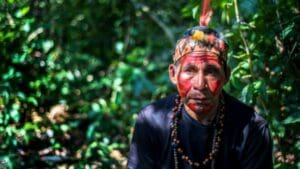To the west of Great Slave Lake, the second-largest lake in Canada’s Northwest Territories, is a plateau that towers 600 meters above the surrounding Mackenzie Valley. The plateau, which features a unique mosaic of boreal forest, wetlands, and lakes, and is home to dozens of at-risk species, including the woodland caribou, wood bison, and waterfowl, is known as the Edéhzhíe Dehcho Protected Area/National Wildlife Area (pronounced eh-day-shae.)
The Edéhzhíe Dehcho Protected Area acts as a natural watershed for rivers and lakes in the territory and is the single largest protected area of woodland caribou in Canada at 14,218 square kilometers (5,490 square miles.) Its protection was initiated and led by Dehcho First Nations as an Indigenous Protected and Conserved Area (IPCA) in collaboration with and funded by the Canadian government. It is just one example of 40 IPCAs currently proposed across Canada.
When the Edéhzhíe Dehcho Protected Area was established in 2018, the already existing Dehcho K’éhodi Stewardship and Guardian Program began supporting its management. The guardian program enables local community members to act as “eyes and ears on the ground,” and to coordinate research and mentor youth in next-generation conservation leadership. They are place-based experts who merge traditional knowledge with western science to monitor ecological health, cultural sites and protect at-risk species on behalf of their communities and wider society. There are currently 70 Guardian programs in operation across Canada and a further 25 in development.
On August 12, the Canadian government announced it will invest CAD $340 million (USD $269 million) over five years to support IPCAs and the Indigenous Guardians Program as part of its commitment to conserving 25% of the country’s lands and waters by 2025 and 30% by 2030. It is the largest single investment in Indigenous land conservation and stewardship in Canada to date and these funds will be directly invested in IPCAs and Indigenous Guardians programs.
In Canada, like in many countries around the world, the creation of national and provincial parks, protected areas, and wildlife reserves in the name of conservation have often resulted in the forced displacement of Indigenous Peoples from their traditional lands and territories. But as research now shows, Indigenous Peoples and local communities’ participation and rights are integral to conserving the natural resources they have subsisted upon for generations.

“We have been on our land for over 700 generations and have learned important lessons around sustainability and natural resource management,” Hereditary Heiltsuk Chief Frank Brown, who is an adjunct professor in resource and environmental management at Simon Fraser University, recently shared with Canada’s National Observer.
“It’s paradoxical that Indigenous Peoples, long excluded and marginalized from decisions around the environment and development in their territories, will be key to meeting the challenges of climate change and biodiversity loss.”
Now, projects like the Edéhzhíe Dehcho Protected Area are paving a new way forward for conservation, one that prioritizes the knowledge, values, and livelihoods of the First Nations, Inuit, and Métis Peoples of Canada.
The Canadian government’s announcement came just days after the Intergovernmental Panel on Climate Change (IPCC) published an alarming report outlining worst-case scenarios if carbon emissions are not curbed in the next decade. It warns of the now inevitable impacts of climate change but also identifies big opportunities to reduce risk.
A growing body of research has shown that Indigenous communities achieve similar, if not better, conservation outcomes than private or state-managed protected areas and do so at a lower cost. Communities seldom, if ever, receive the financial support granted to public or private conservation initiatives.
In the Northwest Territories, Indigenous Guardians programs create about CAD $2.50 of social, cultural, and environmental benefits for every dollar invested in the program. For the Coastal First Nations Guardian Program on the west coast of British Columbia, the return on investment is shown to be 10:1. Indigenous Peoples are the best guardians of the lands and forests that they steward, and their leadership is necessary to prevent a global biodiversity collapse.
“Guardians work on behalf of their Nations, but the jobs they do – responding to wildfires, restoring caribou and salmon, monitoring sustainable development – benefit the whole country,” said Valérie Courtois, Director of the Indigenous Leadership Initiative and a member of the Innu community of Mashteuiatsh.
“Indigenous-led conservation delivers a return on investment for all of us.”
While Canada’s latest investment in IPCAs and the Indigenous Guardians Program is encouraging, there is more to be done, and the Indigenous Leadership Initiative and its partners will continue to work towards securing long-term and permanent funding for Indigenous-led conservation initiatives in Canada.
“Our vision is that every Indigenous Nation in Canada that wants an Indigenous Guardians Program should be able to have one and feel supported,” Courtois said.
For more information, please contact Sean Durkan. The header photo is of Nuxalk Guardian Watchmen monitoring a salmon habitat off the west coast of British Columbia. Photo credit goes to ‘Qatuwas Brown.
To learn more about the Indigenous Leadership Initiative, visit their website.
Interested in receiving notifications about new blog posts? Subscribe to The Land Writes Blog now to get new posts delivered right to your inbox.






